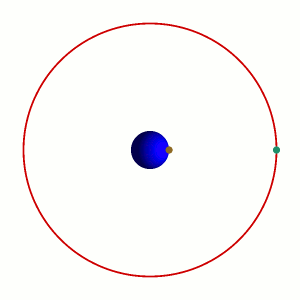



Geosynchronous Orbits - Geostationary:
Geosynchronous orbits are a much abused term in science fiction and so I thought I should shed some light on them.
The most common use of this term is for the situation where a satellite sits motionless above the same point on the surface of the planet. This is a special case for a geosynchronous orbit and is called a ‘Geostationary’ or ‘Clarke’ orbit. And if that last name seems familiar, this orbit is indeed named after the famed science fiction author Arthur C. Clarke who passed away earlier this year (2008). Clarke was a space scientist before he became an author and he was the first to popularise this concept as a means for satellite-based radio communications.
Technically a geosynchronous orbit is one whose orbital period is in some ways synchronised with the rotation of the Earth such that the orbiting body will pass over the same point on the planet at the same time every day. The Geostationary orbit (something of a misnomer as the satellite is actually travelling very fast) is an extreme example of this.
Image Courtesy of Brandir from the
Wikimedia Commons under CC-BY-SA licence.
For a satellite to be in a geostationary orbit it must orbit the Earth along the line of the equator at an altitude of approximately 35,786 kilometres (between 5 to 6 times the radius of the Earth which means its orbits circumference is correspondingly bigger). For the orbit to be stable and self sustaining (i.e. Requiring no energy to maintain) it must be travelling at about 11,000 kph or about 3 kilometres per second. If this is achieved, the satellite will stay directly above a particular spot on the equator as the planet spins on its axis. If either the orbital radius or velocity varies the satellite will lose this special synchronisation and its path will wander in the sky.
I think the most important thing to take away from this is the distance a satellite in geosynchronous orbit is away from the planet’s surface. Considering that the International Space Station is in Low Earth Orbit (LEO) at an altitude of 350 kms, boosting any object to geosynchronous orbit is going to be very energy intensive. Similarly, travel times are going to be significant.
I remember reading one story where someone bombarded a planet’s surface with missiles from what was described as a geosynchronous orbit (yes, the distances will be different for different planets, but not by orders of magnitude). The missiles reached the surface within seconds. There is no way a normal missile is going to travel that far in seconds and, if you could accelerate something with mass that fast, there would be little need to put a warhead on it. The thermal shock of it entering the atmosphere at such speed would be like setting off a nuclear bomb high in the atmosphere.
Next week I will talk briefly about other types of geosynchronous orbits of relevance to authors.
For a more complete discussion on Geostationary Orbits:
http://en.wikipedia.org/wiki/Geostationary_orbit
N.B. Please note that I although I use the Wikipedia (and WikiMedia Commons) a lot for references, this is for expediency and the familiarity of my readers. Anyone interested in further studies should make use of the references where available and understand the Wikipedia is a co-operative project contributable to by anyone and must always be looked at in that light.
Phill Berrie, July, 2008.



